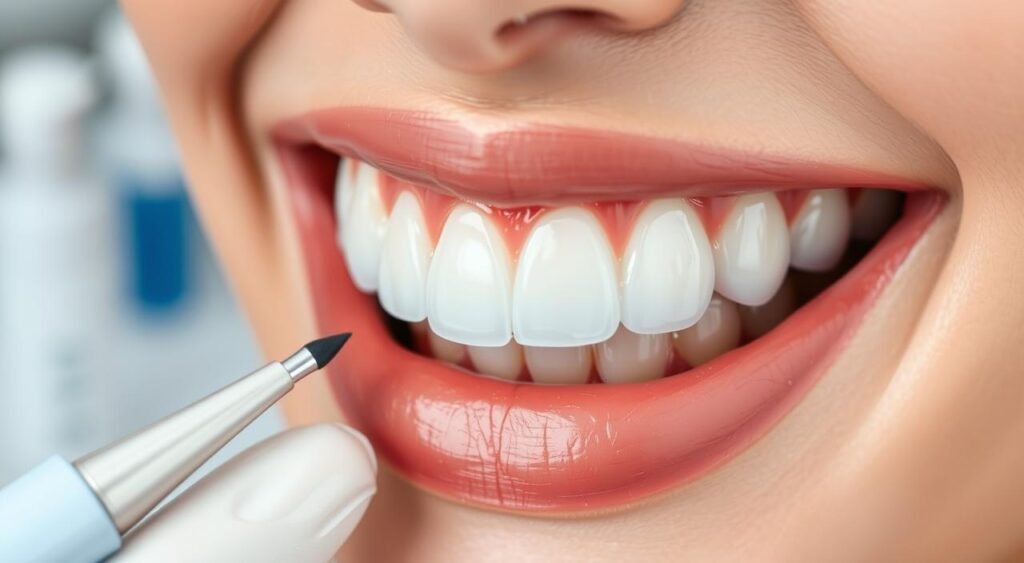Ever wondered why your teeth feel sensitive after whitening? Teeth Whitening and Tooth Sensitivity often go hand in hand as a common side effect. Dental bleaching can remove stains but might cause temporary pain. Let’s look into how whitening and sensitivity are linked to help you smile brighter without pain.
Teeth whitening is a favorite cosmetic dental treatment in the U.S. It’s mostly safe but can make teeth sensitive for a few days. Whitening makes enamel more open, exposing dentin and its nerves.
Did you know 20 million in the UK risked their teeth with unsafe whitening? It’s key to pick safe products and talk to a dentist before whitening. Professional whitening systems often work better and cause less pain than store-bought ones.
Link Between Teeth Whitening and Tooth Sensitivity
Teeth whitening is a popular way to brighten smiles. But, it often causes tooth sensitivity. This discomfort usually lasts a few days to two weeks after treatment. Knowing how whitening and sensitivity are connected can help you manage it better.
Causes of Sensitivity After Whitening
Whitening gels and strips have peroxide. This chemical goes through the enamel to remove stains. It can expose dentin, which has nerve endings. So, your teeth might feel more sensitive to temperature changes and certain foods.
How Whitening Affects Tooth Enamel
Peroxide treatments open pores in your enamel, making teeth more sensitive. But, this effect is usually short-lived. The pores close naturally over time. Using fluoride toothpaste or rinses after whitening can help strengthen your enamel and reduce sensitivity.
Common Symptoms of Sensitivity
If you feel sensitivity after whitening, you might notice:
- Discomfort when consuming hot or cold foods and drinks
- Pain when eating acidic foods
- Increased sensitivity while brushing teeth
To lessen these side effects, try using whitening products with lower peroxide. Or, choose gradual whitening methods. If sensitivity lasts, talk to your dentist for advice on managing discomfort while keeping your smile bright.
Types of Teeth Whitening Treatments
There are many teeth whitening options to fit your needs and budget. You can pick from professional treatments, at-home kits, or over-the-counter products.
In-office whitening gives quick results. Dentists use strong whitening agents for a big change. This method costs $500 to $1,000 and can make teeth three to eight shades whiter. It’s the safest choice for those with sensitive teeth.
At-home whitening kits offer a middle option. They include custom trays with gels. Prices are from $150 to $600. You use them for hours a day for weeks. They’re not as strong as in-office treatments but better than over-the-counter ones.
Whitening toothpastes are easy to find and affordable. They can make teeth about one shade lighter. Some have baking soda to remove mild stains. But they’re not as effective as other methods.
- Store-bought strips and gels: $10 to $55
- Whitening rinses: Contain hydrogen peroxide
- LED light kits: Gentle for sensitive teeth
Keep in mind, results can vary. Yellow teeth usually respond well to whitening. But brown stains are harder to remove, and gray or purple stains might not change much. Always talk to your dentist before starting any whitening treatment, if you have sensitive teeth or gum issues.
Preventing Sensitivity During Teeth Whitening
Teeth whitening can make your smile shine brighter. But, it might also cause some discomfort. By taking the right steps, you can avoid this and enjoy your new smile.
Choosing the Right Whitening Product
Look for a whitening product with a lower peroxide level (6% to 10%). This can help lower the risk of sensitivity. At-home kits are gentler because they have less concentrated bleaching agents.
Professional treatments can make your teeth several shades whiter in about 90 minutes. They offer better results with less sensitivity.
Preparing Your Teeth Before Treatment
Start using desensitizing toothpaste a week before whitening. This helps build up your enamel and reduces sensitivity. Also, make sure to get dental check-ups before treatment to fix any issues.
Fluoride treatments can strengthen your enamel and protect against sensitivity. This is important for keeping your teeth healthy during whitening.
Professional vs. Over-the-Counter Options
Professional whitening is more controlled and causes less sensitivity. Dentists use custom-fitted trays to avoid gum contact. They might also add potassium nitrate-fluoride to the bleaching agents to reduce sensitivity.
Over-the-counter options are good for mild whitening but might cause more sensitivity in some cases.
Here are some tips to prevent sensitivity:
- Take over-the-counter pain medication 30 minutes before treatment
- Avoid hot or cold foods right after whitening
- Wait a few hours before brushing your teeth post-treatment
- Use fluoride rinses to protect your teeth
If sensitivity lasts, talk to your dentist about more desensitizing treatments. With the right care, you can have a brighter smile without discomfort.

Managing Tooth Sensitivity After Whitening
Teeth whitening makes your teeth look brighter, but it can also make them sensitive. Don’t worry, there are ways to handle this and keep smiling.
Start by being gentle with your teeth. Use a soft-bristled toothbrush and lukewarm water. This protects your enamel and lessens irritation. For a few days, avoid hot, cold, and acidic foods.
Desensitizing products are great for sensitive teeth. Look for toothpaste made for this issue. It blocks pain signals. You can also use desensitizing gels for quick relief on sensitive spots.
- Use fluoride treatments to strengthen your enamel
- Try drinking through a straw to minimize contact with sensitive teeth
- Apply a cold compress to your cheek for temporary relief
Saltwater rinses can also help. Mix a teaspoon of salt in warm water and swish it around your mouth. This natural remedy can ease inflammation and pain.
If sensitivity lasts, see your dentist. They might suggest professional fluoride treatments or other solutions. With the right care, you can enjoy your brighter smile without pain.
Teeth Whitening and Tooth Sensitivity: Best Practices
Getting a brighter smile can really boost your confidence. But, it’s important to follow the right steps to avoid sensitivity and keep your teeth looking good. Let’s look at some key tips for whitening your teeth well and when to see a dentist.
Proper Application Techniques
When you use whitening products, make sure to follow the instructions closely. Spread the product evenly and don’t get it on your gums. For strips, make sure they cover all your teeth. With trays, use just the right amount of gel to avoid spills.
Rinse your mouth well after using the product to get rid of any leftover.
Frequency of Whitening Treatments
Do teeth whitening no more than once or twice a year to protect your teeth. Doing it too much can hurt your enamel and make your teeth more sensitive. Give your teeth time to heal between treatments.
Keep your teeth looking good by brushing twice a day and flossing regularly.
When to Consult a Dentist
See a dentist before you start whitening your teeth. They can check for cavities or gum disease that could get worse with whitening. They can also suggest the best products for your teeth.
If you have ongoing sensitivity or gum problems after whitening, talk to your dentist right away.
- Get a dental exam before whitening
- Discuss sensitivity concerns with your dentist
- Consider professional treatments for best results
- Ask about desensitizing products if needed
Remember, taking good care of your teeth and gums is key to a bright smile. By following these tips and seeing a dentist when needed, you can have whiter teeth without too much discomfort.
Long-Term Care for Whitened Teeth
After whitening your teeth, you’ll want to keep them looking bright. Stain prevention is key to maintaining that dazzling smile. Avoid foods and drinks that can stain your teeth for at least 48 hours after whitening. Coffee, red wine, and dark juices are common culprits. When you do indulge, use a straw to minimize contact with your teeth.
Oral health maintenance is key to keeping your teeth white. Brush twice daily with a soft-bristled toothbrush and floss regularly. Use a whitening toothpaste for daily upkeep. This helps remove surface stains and keeps your smile bright.
Consider occasional whitening touch-ups to maintain your results. Over-the-counter products can work, but they’re not as strong as professional treatments. If you choose this route, follow the instructions carefully to avoid sensitivity. For best results, consult your dentist about the right whitening schedule for you.
- Wait 24 hours after whitening before brushing
- Use a straw for dark beverages
- Avoid smoking for at least 48 hours post-whitening
- Maintain a diet low in staining foods
Remember, teeth whitening is one of the most popular cosmetic dental procedures. With proper care, you can enjoy your brighter smile for longer. Stick to good oral hygiene habits and be mindful of what you eat and drink. Your efforts in stain prevention and oral health maintenance will pay off with a lasting, radiant smile.
Conclusion
Teeth whitening can greatly improve your smile and confidence. Studies show that brighter smiles are linked to being seen as more successful and attractive. But, it’s important to be careful to avoid sensitivity and keep your teeth healthy.
Tooth sensitivity is a common side effect of whitening, ranging from mild to severe. Choosing the right method and following best practices can help. This way, you can get a brighter smile with less discomfort. Remember, managing sensitivity is key to a good whitening experience.
Always talk to a dental professional before starting any whitening treatment. They can find the best method for you and teach you how to use it right. By focusing on your oral health and following their advice, you can enjoy a brighter smile without harming your teeth.
In the end, a brighter smile can make you feel more confident and improve your dental health. With the right approach to whitening and managing sensitivity, you can get the smile you’ve always wanted. This way, you won’t have to sacrifice your comfort or oral health.
FAQ – Tooth Sensitivity and Teeth Whitening
What causes tooth sensitivity after teeth whitening?
Tooth sensitivity after whitening comes from exposing the dentin layer. This layer has nerve endings. The whitening process makes the enamel more permeable. This lets the whitening agents reach and irritate the nerves in the dentin.
Are there different types of teeth whitening treatments?
Yes, there are many teeth whitening options. You can get professional in-office treatments or use at-home kits. There are also over-the-counter products like strips and toothpastes.
How can I prevent sensitivity during teeth whitening?
To avoid sensitivity, start with a desensitizing toothpaste 10 days before whitening. Use desensitizing gel before whitening. Choose your products wisely, and get a dental check-up first.
What are the best practices for managing tooth sensitivity after whitening?
After whitening, avoid hot, cold, and acidic foods for 48 hours. Keep using desensitizing toothpaste and gel. Brush gently and use fluoride products. Drink through a straw to avoid sensitive teeth.
How often should I whiten my teeth?
Whiten your teeth once or twice a year, or as your dentist suggests. Whitening too often can damage the enamel and cause sensitivity.
When should I consult a dentist about teeth whitening and sensitivity?
See a dentist if you have ongoing sensitivity or dental issues. They can offer personalized advice and monitor your teeth during whitening.
How can I maintain whitened teeth long-term?
To keep your teeth white, brush and floss well. Avoid staining foods like coffee and red wine. Use whitening toothpaste daily. Get touch-ups and dental check-ups regularly.








